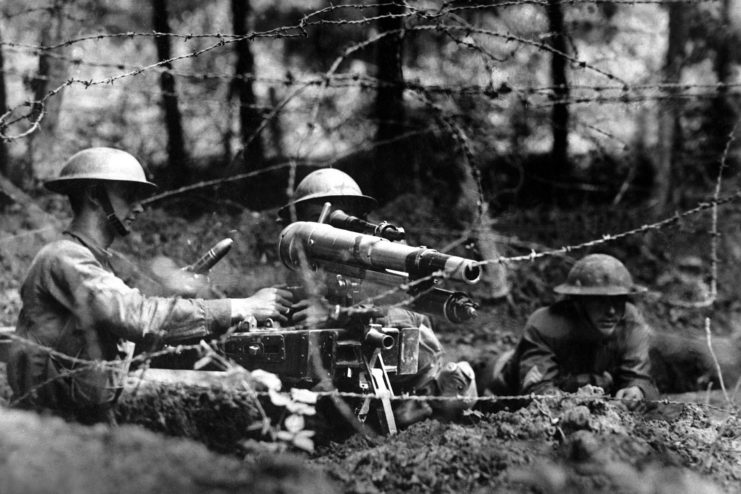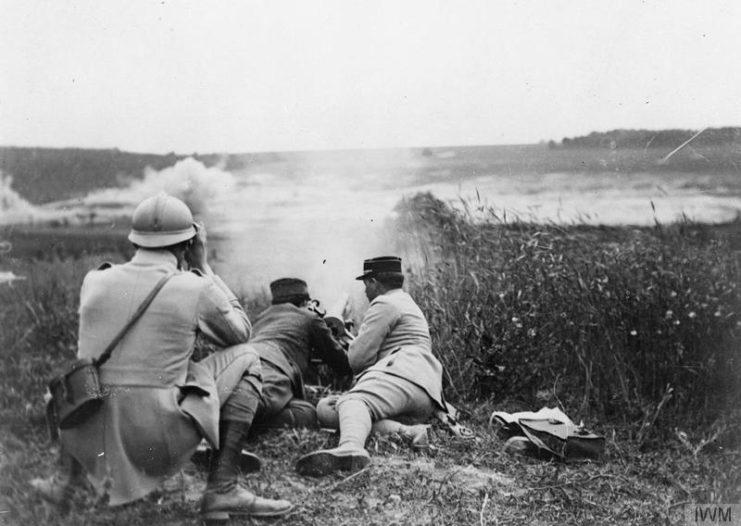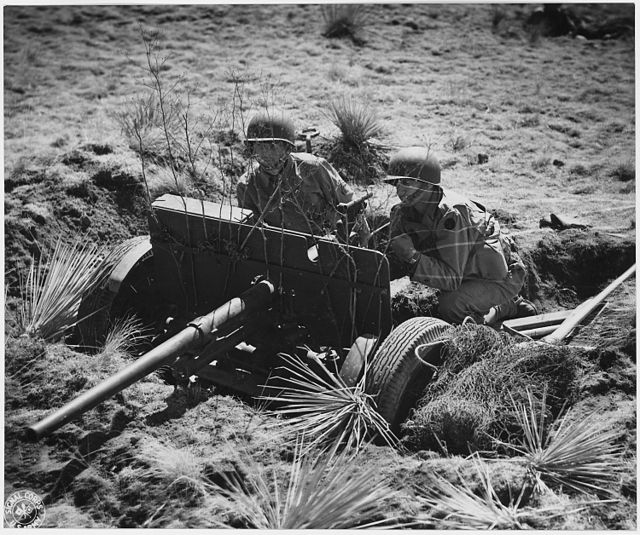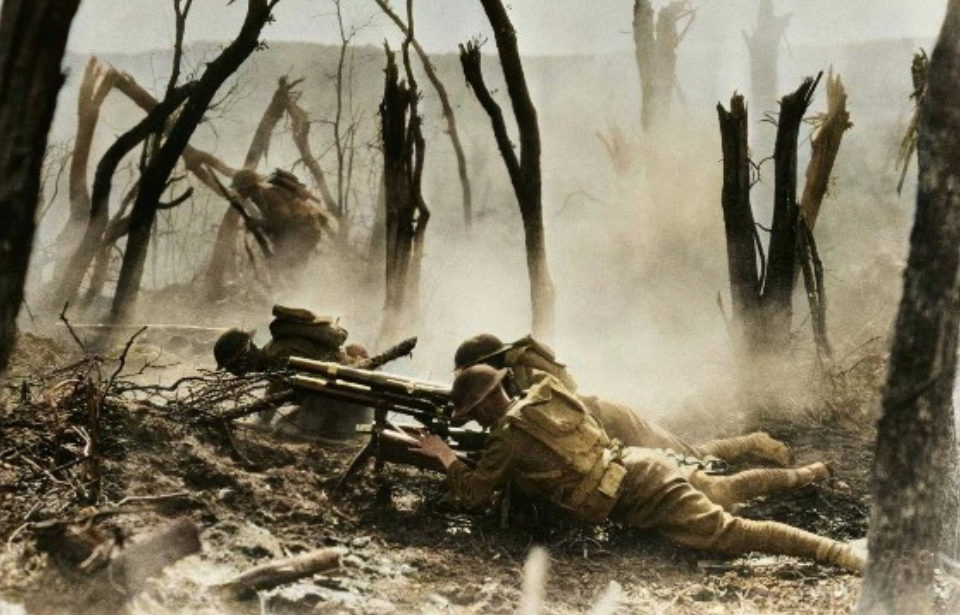As the First World War commenced in 1914, the need for modern, advanced weaponry became increasingly evident. This was especially pronounced on the battlefield, where infantry soldiers grappled not only with intricate trench systems, but also with fortified bunkers and well-entrenched machine gun positions.
In response to these challenges, the French Army introduced the 37 mm M1916. Despite the weapon’s initial aspirations to excel on the Western Front, the reality unfolded quite differently, rendering it virtually obsolete by the midpoint of World War II.
Developing a potent infantry weapon

The 37 mm M1916, officially designated as the Canon d’Infanterie de 37 modèle 1916 TRP, emerged in 1915. Its primary aim was to equip infantrymen with an effective weapon capable of disrupting enemy actions and facilitating the advancement of the front. Additionally, it sought to offer a means of neutralizing enemy positions, such as barbed wire barriers and machine gun nests.
The Atelier de Construction de Puteaux (APX) was entrusted with the design and production of the weapon, resulting in the manufacture of 4,000 units. In addition to its deployment on the frontlines, the 37 mm M1916 underwent testing on various aircraft, including the British Beardmore W.B.V. single-engine shipborne biplane fighter prototype and the French Salmson-Moineau S.M.1 A3 three-seat biplane long-range reconnaissance aircraft.
It was, however, swiftly removed from the former after proving to be too perilous an addition.
37 mm M1916 specs

The 37 mm M1916 was a 104-pound gun and recoil mechanism mounted upon an 84-pound carriage. With the addition of wheels, it could be broken down and carried by four soldiers, two of whom served as its gun crew, taking the roles of aimer and loader.
The infantry weapon was designed to fire the smallest caliber allowed for explosive shells under the 1899 Hague Convention. It used the 37 x 94 mm Obus explosif Mle1916 high-explosive (HE) round, which featured a 1.22-pound projectile and a bursting charge weighing 0.66 pounds. Through its rotating breech-block and hydraulic recoil absorption system, the 37 mm M1916 could produce a rate of fire of between 25 and 35 RPM, with a minimum range of 1,500 meters and a maximum of 2,400 meters.
Also equipped by the American Expeditionary Forces (AEF), the US version was assigned an ammunition limber. It fired the Mk II HE shell with a 1.5-pound projectile and a 0.59-pound TNT bursting charge.
Use on the frontlines during World War I

Over the course of its service history, the 37 mm M1916 was used by forces from the United States, the United Kingdom, the Philippines, Belgium, France, Poland, Italy and North Vietnam, the latter of which equipping it during the First Indochina War. However, the weapon saw much of its action on the Western Front during the First World War.
In May 1918, the French deployed the Renault FT-17 to the frontlines. The world’s first modern tank, it could travel at 5 MPH while providing much-needed mobile fire support for troops fighting the Germans during the war’s final Allied offensive. Around half of the FT-17s that saw action were equipped with the 37 mm M1916, while the other 50 percent saw their firepower come from 8 mm Hotchkiss M1914 machine guns.
It’s also noted that famed French fighter ace René Fonck‘s SPAD S.XII was equipped with a 37 mm M1916. The pilot, known as the “all-time Allied Ace of Aces” and the top Entente fighter ace of World War I, is credited with 75 confirmed victories – 72 solo and three shared – with a total of 142 claimed.
The 37 mm M1916 saw extensive use with the AEF fighting in Europe. Outside of the country’s infantry, it was also equipped by the country’s license-built near-copy of the FT-17. However, the tanks were completed too late to enter service during the war and, as such, none saw action.
Issues with the 37 mm M1916 on the Western Front

While it was developed for use on the Western Front, the 37 mm M1916 actually proved to be a hindrance. At 104 pounds, it was difficult to transport across the muddy conditions of No Man’s Land, and its large size meant it was difficult to transport across the trenches that lined the frontlines. The weapon’s weight also meant its operators were often unable to keep up with the fast-paced nature of the conflict.
On top of this, the 37 mm M1916 wasn’t the best at performing the task it was designed for: destroying enemy machine gun emplacements. Mortars proved to be far more effective. This, paired with their lighter weight, made them the preferred choice.
Superseded by more effective weapons during World War II

During the interwar period, the US Army created infantry regiments with howitzer companies, which were armed with a host of support weapons, including the 37 mm M1916. However, only the National Guard could afford to maintain them, with the Army having to settle for platoons, which trained using a cost-effective .22-caliber sub-caliber device. These units were disbanded in 1941 and replaced by anti-tank platoons, with the majority of the 37 mm M1916s either being scrapped or placed in storage.
When the US joined the Second World War following the Japanese attack on Pearl Harbor, the 37 mm M1916 had largely been replaced by the more effective 37 mm gun M3, the first anti-tank gun fielded by the country’s forces in numbers. The Americans fighting in the Philippines Campaign in 1941-42 did occasionally man the WWI-era weapon, but only because they were running low on available M3s.
The French Army was still equipped with the 37 mm M1916 at the start of the conflict, but, by 1940, it had been replaced by the 25 mm Hotchkiss anti-tank gun. Similar to the US forces, they occasionally had to return to the bulkier canon when the latter was in short supply. When the Germans occupied the country following the Battle of France, they captured a number of 37 mm M1916s, which they operated under the designation 3.7 cm IG 152(f).
Type 11 37 mm infantry support gun

Following WWI, the Imperial Japanese Army (IJA) purchased a production license to manufacture their own variant of the 37 mm M1916. Dubbed the Type 11, it provided infantry support for troops fighting in the Second Sino-Japanese War and WWII.
Production of the Type 11 occurred between 1922-37, with the weapon itself being equipped from 1922-45. It required a crew of 10 to operate – four gunners and six support personnel – and fired both the powerful Type 12 HE and a rather ineffective anti-tank shell. Along with being carried onto the front by soldiers for use against enemy machine gun positions, the Type 11 was equipped by the Japanese Renault NC27 and Type 89 I-Go medium tanks.
More from us: MG 13: The German Second-String Light Machine Gun That Saw Frontline Service In France
During the early years of the Second Sino-Japanese War, the Type 11 was considered an effective infantry weapon against enemy pillboxes, lightly-armored vehicles and machine gun nests. However, it failed to hold the same prestige during the Second World War, due to its low muzzle velocity and rate of fire, and it was largely replaced by the Type 94 37 mm anti-tank gun. Only reserve units found themselves equipped with the Type 11.
